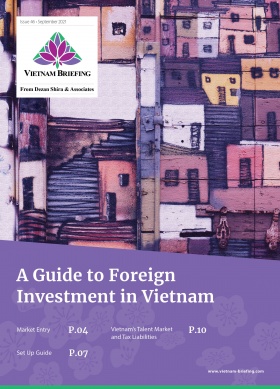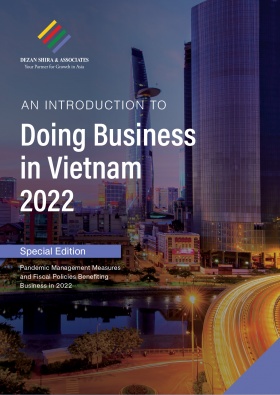Vietnam’s Pharmaceuticals Industry: A Comprehensive Guide for 2022
- Vietnam’s pharmaceutical industry is among the highest growth markets in the region.
- The majority of domestic suppliers lack sufficient resources to fully exploit the market.
- Vietnam Briefing looks at opportunities as well as challenges for foreign investors when investing in the country’s pharmaceutical industry.
Vietnam’s pharmaceutical market was valued at around US$10 billion in 2020, compared to US$5 billion in 2015. As per market research firm IBM, the size of Vietnam’s pharmaceutical industry may reach US$16.1 billion in 2026. According to IQVIA, the industry also observed a 2 percent increase year-on-year, achieving a compound annual growth rate (CAGR) of 6 percent in the period 2018-2020.
Local consumer trends
Vietnam has a relatively large market size with a population of over 98 million and a life expectancy of approximately 76 years. Around 30 percent of the Vietnamese population that can afford relatively expensive western medicine is growing, equal to 30 million – the size of the entire Australian population. The industry also enjoys surrounding emerging markets with similar demands as Vietnam with a collective market size of 280 million including Thailand, Malaysia, Cambodia, Laos, and Singapore.
Vietnam’s pharmaceutical industry is one of the highest growth markets in the region thanks to increasing economic growth, rising income per capita, and an aging population.
As per the World Bank, the number of Vietnamese people aged 65 and over, reached 7.6 million in 2020 accounting for nearly 7.9 percent of the country’s total population. The General Statistics Office (GSO) forecasts that the number will reach 18.1 percent by 2049.
According to a report by the Vietnam Social Insurance Agency, in 2010, only 60 percent of Vietnam’s population had health insurance, while in 2019, this figure was up to 90 percent. Another driving force for the pharmaceutical industry is the rapid urbanization rate. Vietnam’s urbanization rate was at 37 percent in 2020 and in 2021 the urban population stood at approximately 36.6 million.
According to a study conducted by the EU-Vietnam Business Network (EVBN), 80 percent of individuals in Vietnam buy drugs from private pharmacies and self-medicate. Consumers are able to obtain drugs without a prescription, with common sources of information for decision-making when buying drugs being relatives or friends. Non-original and fake drugs can often find their way into pharmacies and clinics, hence buyers value brands known to them and advice from people close to them.
The pharmaceutical production and business system are expanding with about 250 manufacturing plants, 200 import-export facilities, 4,3000 wholesale agents, and more than 62,000 retail agents.
Major pharmaceutical companies in Vietnam are clustered in and around the capital Hanoi, Hai Duong province, Ho Chi Minh City, and some Southwest provinces including Can Tho City and Dong Thap province.
To meet increasing demand, many large pharmaceutical manufacturing enterprises such as Hau Giang Pharmaceutical, Bidiphar, Imexpharm, and Pymepharco have been investing in upgrading factories, aimed at making breakthroughs in developing new domestic pharmaceutical products as well as improving the competitiveness with imported products.
Remarkedly, Hai Duong province has recently confirmed its cooperation with Indian partners on a large-scale pharmaceutical park. The pharmaceutical park project is expected to be worth US$10-12 billion invested by Indian businesses. The Pharmaceutical Park project covers more than 900 hectares of land area in Binh Giang and Thanh Mien districts, the largest of its kind in Hai Duong province.
For Hai Duong, the project will also help welcome international investors, especially those in hi-tech industries. For Vietnam as a whole, it signals the country’s headway for future growth in the pharmaceutical industry.
Vietnam’s bidding and grade system
It takes about five years for a drug to enter the Vietnamese market after it has been developed, beginning with two and a half years of clinical trials, and then another two and a half years to receive approval from the government.
Vietnam uses a grading system to divide companies into different groups that decide how much they can be involved in bidding; a grade of 1 provides the most freedom and 5 the least.
Grade 1:
- Countries that are part of the International Conference on Harmonization (ICH); or
- Pharmaceutical companies that are based in Australia; or
- Manufacturers certified by PIC/S GMP or EU GMP; or
- Manufacturers that have won the World Health Organization’s (WHO) GMP certification given by the Vietnamese government and sell their products to members of ICH.
Grade 2:
- Companies must be part of the European Union CMP or certified with GMP by PIC/S.
Grade 3:
- Pharmaceutical producers who have achieved WHO’s FMP awarded by the Vietnamese government.
Grade 4:
- The products must have gone through the bioequivalence
Grade 5:
- All other drugs.
A potential market but underdeveloped industry
Despite rapid growth, Vietnam’s production capacity can only meet 53 percent of domestic pharmaceutical demand. In 2018, Vietnam’s spent nearly US$2.8 billion on importing pharmaceuticals, and in 2021, that number jumped to US$4 billion according to GSO.
Major import markets include France, Germany, India, United States, South Korea, Italia, and Belgium with antibiotics being the leading import product.
| Vietnam’s Pharmaceutical Imports | |
|---|---|
| Year | Import Value |
| 2018 | US$2.8 billion |
| 2020 | US$3.3 billion |
| 2021 | US$4 billion |
In addition, pharmaceutical R&D activities are lacking serious investment. While the government has prioritized advancing its domestic pharmaceutical industry, the country’s capabilities are still limited to generic medicines (pharmaceuticals whose exclusive protection is expired), simple dosage forms, and functional foods.
Vietnam is also highly dependent on imported pharmaceutical materials, of which Chinese and Indian sources account for more than 85 percent. With its favorable tropical ecosystem, Vietnam has significant potential to grow medical plants, such as cinnamon.
However, the government still has no specific plans to develop large-scale medicinal plant growing areas at a national level. Some reputable local manufacturers have started developing their own medicinal plant farms, they only manage to meet a small amount of demand for production though.
Additionally, the input material is mostly imported from a few major markets, which has negatively affected the industry by increasing production costs and indirectly passing the cost onto the customers.
Such consequences were observed in late 2019 when the COVID-19 outbreak led to temporary shutdowns of many manufacturers in China and India, resulting in a shortage of pharmaceutical input ingredients in Vietnam.
Vietnam also lacks the appropriate supply chains to increase exports to more profitable regulated markets. Furthermore, many of the domestically produced and registered drugs may not comply with GMP (Pharmaceutical Inspection Co-operation Scheme Good Manufacturing Practice) standards observed in regulated markets, with 2-3 percent of drugs per annum failing to meet national quality standards.
Opportunities
Unlike the Chinese and Indian markets, local competition for innovative and complex treatments is not a threat to new investors as even major domestic manufacturers are still small and medium in size with limited capital, R&D resources as well as supply chains.
Therefore, with the right strategy, foreign pharmaceutical companies can benefit by involving in this early stage of the industry supply chains as there are yet to be large competitors in the market.
Investors can also take advantage of the preferential tariffs under agreements like the EU-Vietnam free trade agreement (EVFTA). EU investors are now allowed to establish a company to import pharmaceutical products and sell to local distributors or wholesalers. EU investors are also allowed to build warehouses and carry out clinical research and trials.
As per the EVFTA, Vietnam will also align with international standards on pharmaceuticals which means that products already certified in the EU will not require additional testing and certification in Vietnam, thus reducing time and costs in the Vietnamese market.
Challenges
One of the key challenges for foreign pharmaceutical businesses operating in Vietnam is that FDI logistic companies and foreign pharmaceutical companies are not permitted to distribute pharmaceutical products directly and must sell their products to domestic pharmaceutical distributors.
However, the distribution network is still fragmented, inefficient, and suffers from poor transparency. This system is subject to significant price distortion with hospital procurement involving bids that are 130-245 percent higher than the procurement price added with logistic costs.
Another challenge for MNCs operating in Vietnam is the potential delays in regulatory approval for new medicines. The Drug Administration of Vietnam remains the only branch of the Ministry of Health responsible for managing and approving market authorization, assessing GMP, and releasing business and product licenses.
Therefore, initial reviews can be expected to take up to a year, while clinical trials can take up to at least three years, and assessment of stability data adds another year. Such a lengthy regulatory procedure may undermine the competitiveness of any foreign pharmaceutical enterprise that aims for further approval for the US and European markets while making it more challenging for these companies to recoup the investment.
Advertising is another area that should be of concern to pharmaceutical businesses in Vietnam. Advertising of over-the-counter drugs is allowed in Vietnam, but the advertising of prescription drugs is illegal. This could create problems for the public to find access to a drug.
Market entry strategies
In spite of all the barriers facing foreign producers, the best way to enter the market and become established in Vietnam is to find a local partner that has the ability to form connections with pharmaceutical distributors. Using this strategy, one can also eliminate some of the challenges faced with brand awareness due to the restrictions on advertising in Vietnam.
Finding a local company to start such a joint venture or an M&A is an important first step to entering the market in Vietnam.
Other market entry options include investing in the form of a drug importer, operating a manufacturing company through an M&A, and participating in pharmaceutical-related bidding packages of certain central and local state agencies. In our experience, an M&A is one of the best options to enter the Vietnamese market.
Though Vietnam has implemented steps to reduce its dependence on imports and develop its domestic industry, most drugs are still imported, including raw materials. This offers an opportunity for companies to become involved in the industry supply chains with the right market entry strategies.
Takeaways
The pharmaceutical industry in Vietnam is a promising market for growth in Asia with increasingly higher demand thanks to an expanding population, improved income, increasing urbanization, and environmental conditions.
Nevertheless, lack of proper development and investment are the main concerns for the country’s pharmaceutical industry. In order to efficiently elevate the standards of the domestic pharmaceutical industry, Vietnamese companies and regulatory bodies will need to rely on a transfer of knowledge, skills, and resources from foreign partners.
Pharmaceutical companies also need to look to other suppliers besides major markets like China and India to ensure a sufficient supply of raw materials for production to meet the increasing demand.
About Us
Vietnam Briefing is produced by Dezan Shira & Associates. The firm assists foreign investors throughout Asia from offices across the world, including in Hanoi, Ho Chi Minh City, and Da Nang. Readers may write to vietnam@dezshira.com for more support on doing business in Vietnam.
We also maintain offices or have alliance partners assisting foreign investors in Indonesia, India, Singapore, The Philippines, Malaysia, Thailand, Italy, Germany, and the United States, in addition to practices in Bangladesh and Russia.
- Previous Article Personal Income Tax in Vietnam: Deadlines, Requirements, and Preparation
- Next Article Manufacturing in Vietnam: Key Labor Concerns and How to Optimize Your HR Strategy






























